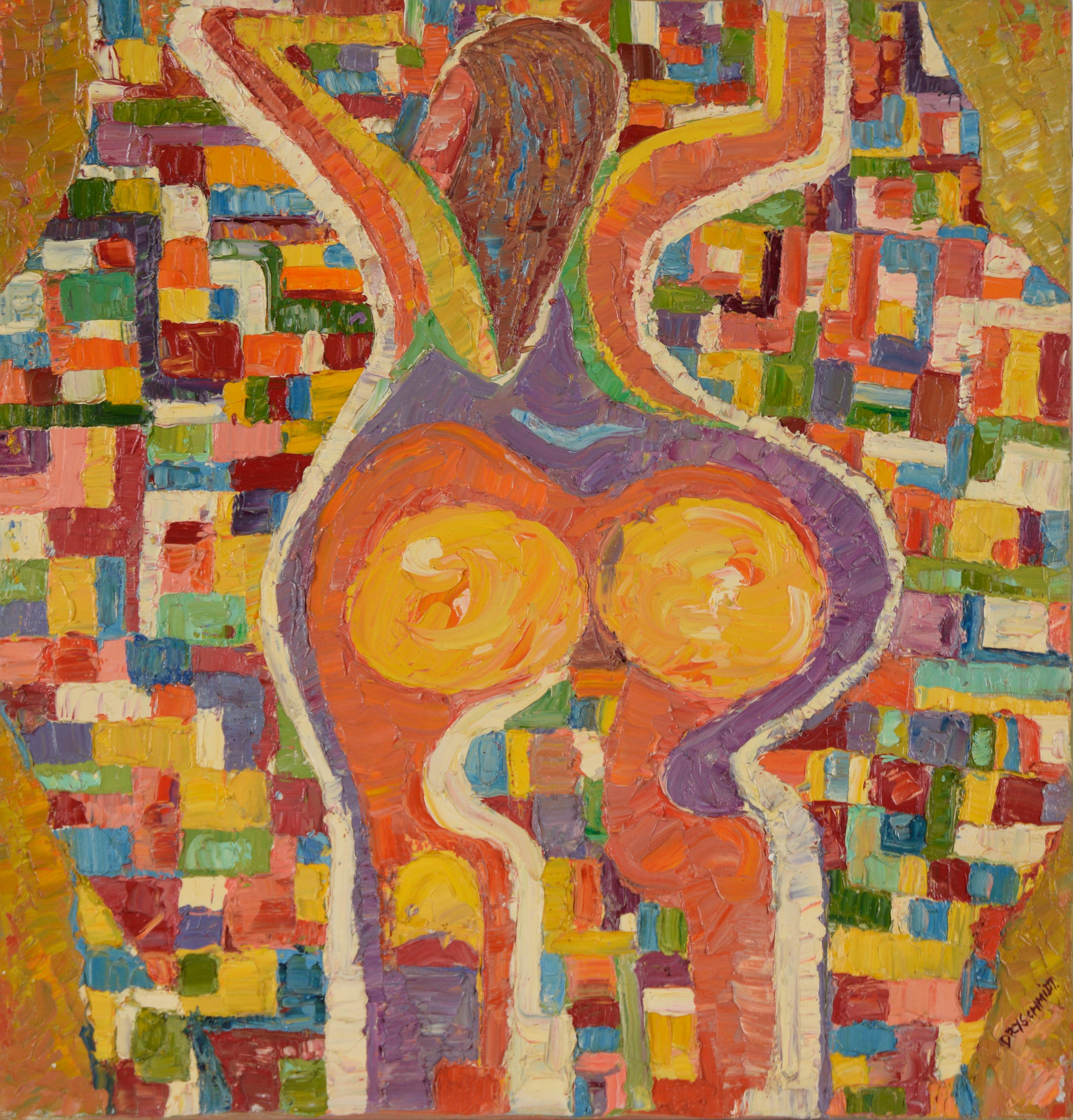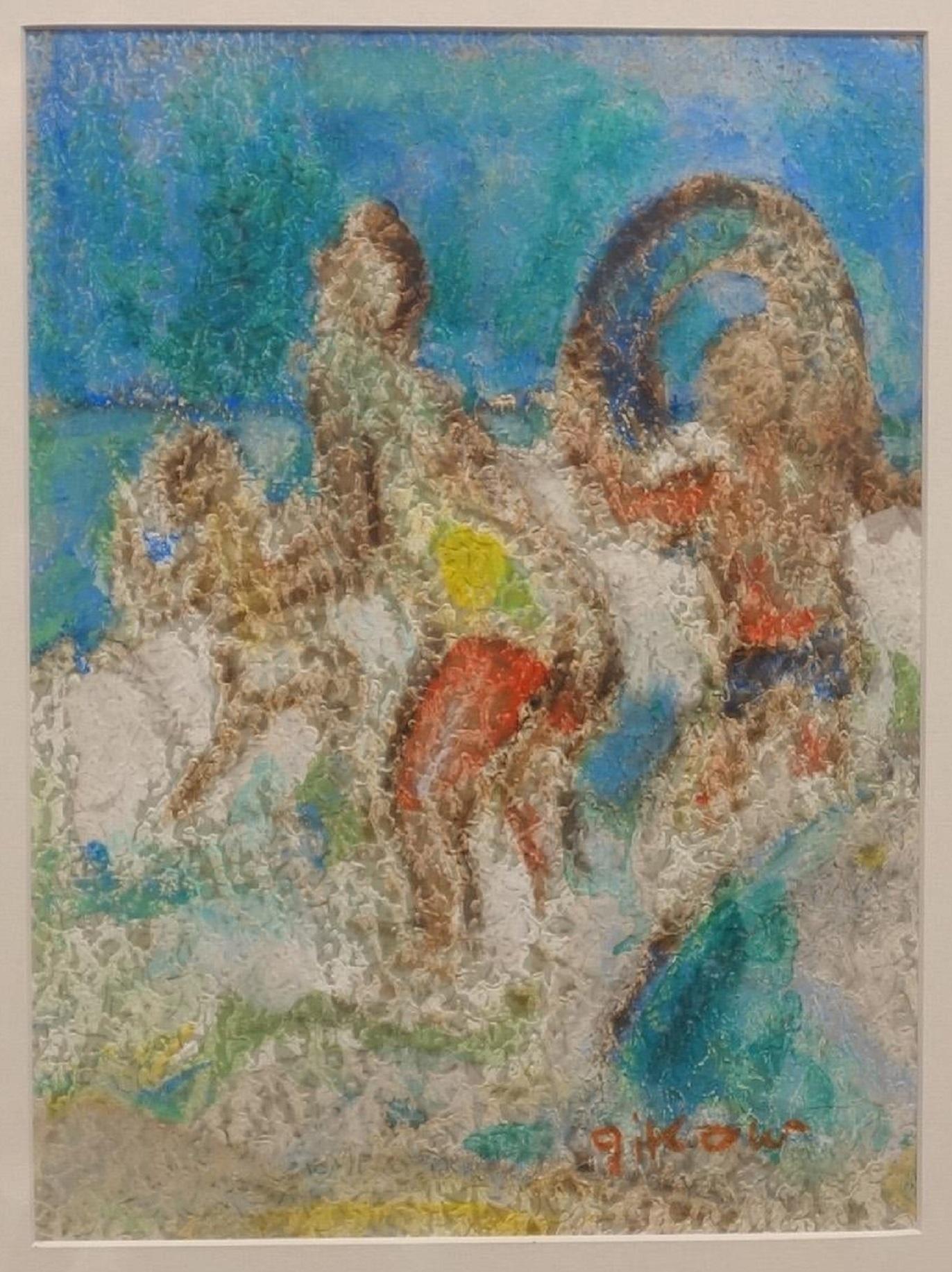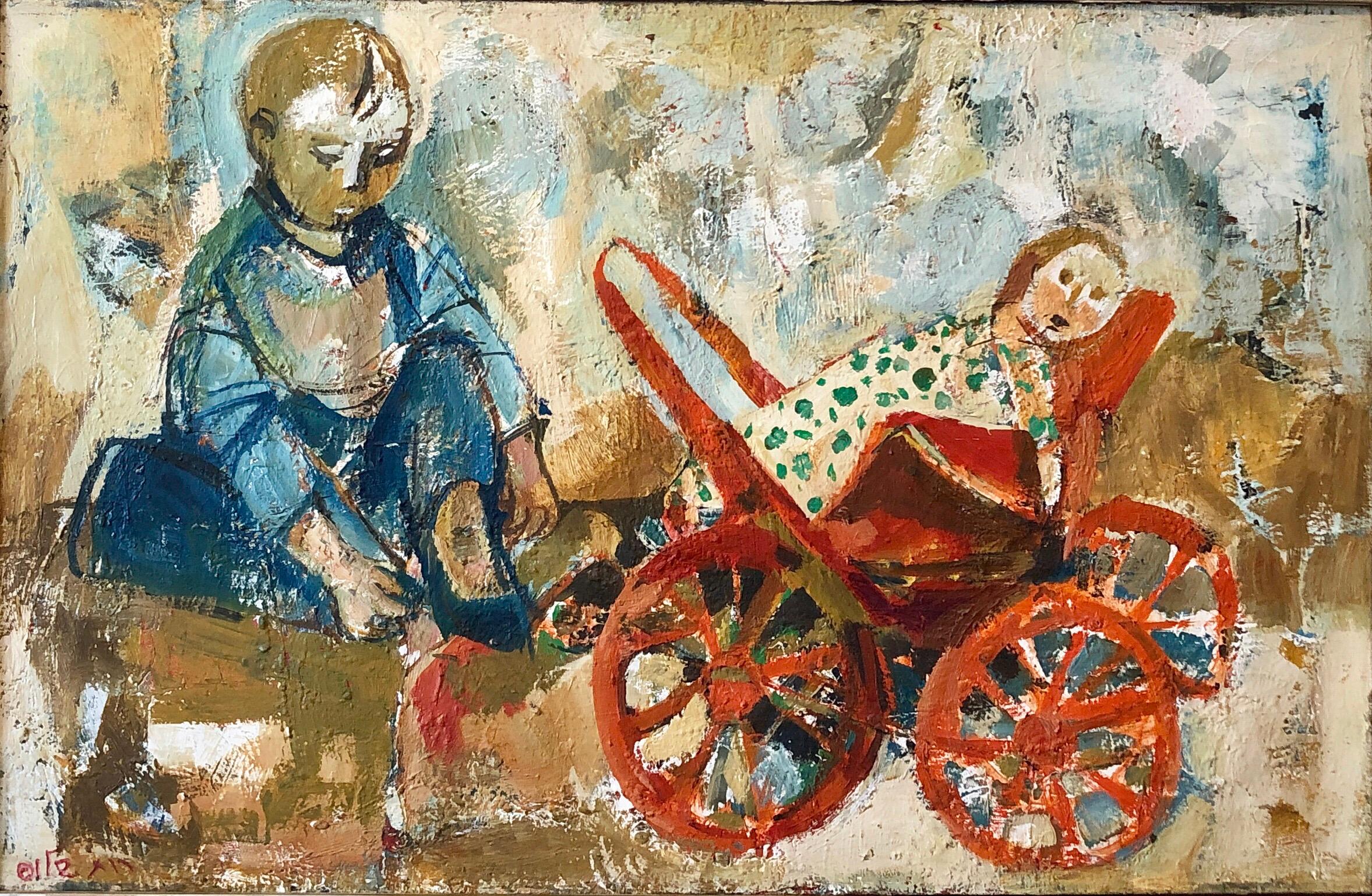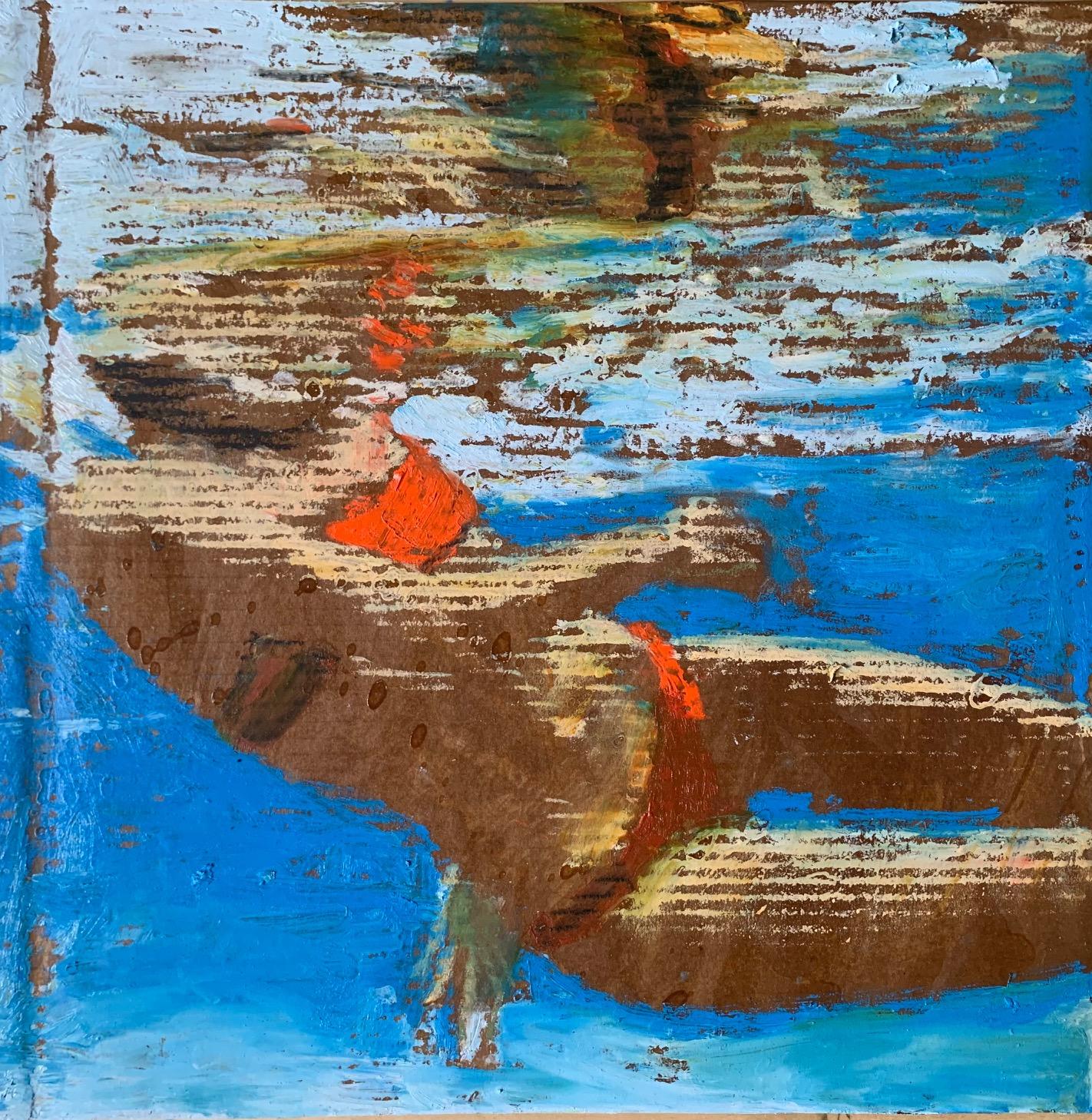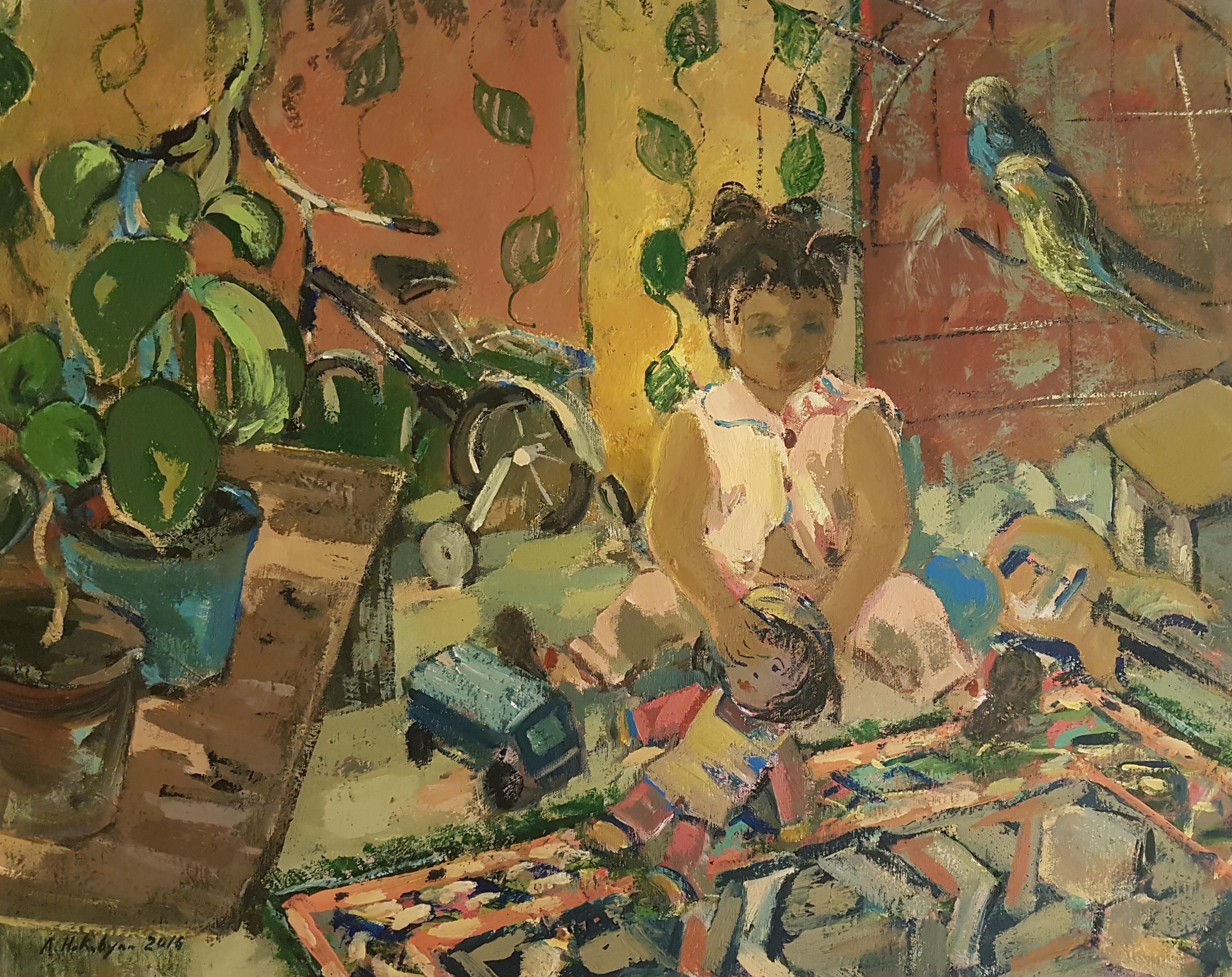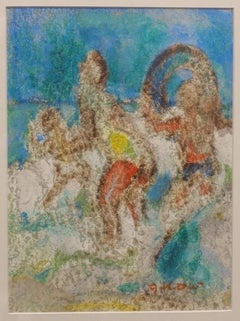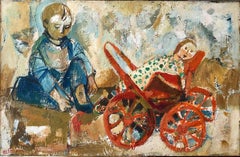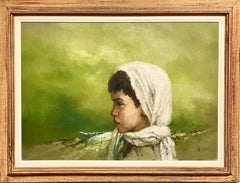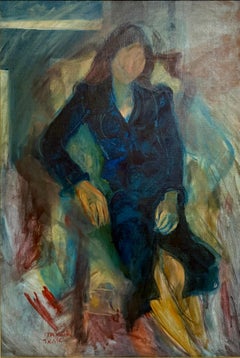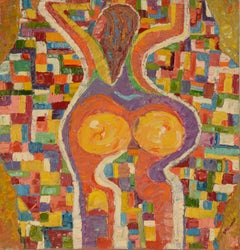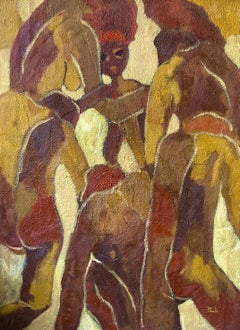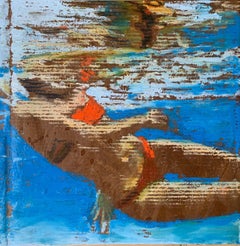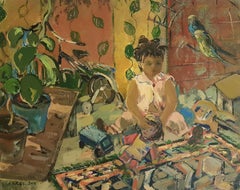Items Similar to Israeli KIbbutz Artist Toddler, Swim Tube Pointilist Oil Painting Bezalel School
Want more images or videos?
Request additional images or videos from the seller
1 of 8
Arie KaplunIsraeli KIbbutz Artist Toddler, Swim Tube Pointilist Oil Painting Bezalel School
$2,000
£1,518.37
€1,736.69
CA$2,794.29
A$3,107.86
CHF 1,622.83
MX$37,819.36
NOK 20,725.99
SEK 19,437.32
DKK 12,961.56
Shipping
Retrieving quote...The 1stDibs Promise:
Authenticity Guarantee,
Money-Back Guarantee,
24-Hour Cancellation
About the Item
Belarusian born Israeli artist. lived in germany studied at the Bezalel School.
Bezalel Academy of Arts and Design is Israel's national school of art. Established in 1906 by Jewish painter and sculptor Boris Schatz, Bezalel is Israel's oldest institution of higher education.
The "Bezalel School of Art and Craft" was founded in 1906 by Boris Schatz, who envisaged the creation of a national style of art blending classical Jewish/Middle Eastern and European traditions. The school opened in rented premises on Ethiopia Street. It moved to a complex of buildings constructed in the 1880s surrounded by a crenelated stone wall, owned by a wealthy Arab. In 1907, the property was purchased for Boris Schatz by the Jewish National Fund. Schatz lived on the campus with his wife and children. Bezalel's first class consisted of 30 young art students from Europe who successfully passed the entrance exam. Eliezer Ben Yehuda was hired to teach Hebrew to the students, who hailed from various countries and had no common language.
In addition to traditional sculpture and painting, the school offered workshops that produced decorative art objects in silver, leather, wood, brass, and fabric. Many of the craftsmen were Yemenite Jewish silversmiths who had a long tradition of working in precious metals, as silver- and goldsmithing, which had been traditional Jewish occupations in Yemen. Yemenite immigrants were also frequent subjects of Bezalel artists.
In 1912, Bezalel had one female student, Marousia (Miriam) Nissenholtz, who used the pseudonym Chad Gadya.
Bezalel closed in 1929 in the wake of financial difficulties. After Hitler's rise to power, Bezalel's board of directors asked Josef Budko, who had fled Germany in 1933, to reopen it and serve as its director. The New Bezalel School for Arts and Crafts opened in 1935, attracting many teachers and students from Germany, many of them from the Bauhaus school shut down by the Nazis. Budko recruited Jakob Steinhardt and Mordecai Ardon to teach at the school, and both succeeded him as directors.
In 1958, the first year that the prize was awarded to an organization, Bezalel won the Israel Prize for painting and sculpture.
Bezalel Pavilion near Jaffa Gate
Bezalel pavilion was a tin-plated wooden structure with a crenelated roof and tower built outside Jaffa Gate in 1912. It was a shop and showroom for Bezalel souvenirs. The pavilion was demolished by the British authorities six years later.
Bezalel developed a distinctive style of art, known as the Bezalel school, which portrayed Biblical and Zionist subjects in a style influenced by the European jugendstil (art nouveau) and traditional Persian and Syrian art. The artists blended "varied strands of surroundings, tradition and innovation," in paintings and craft objects that invokes "biblical themes, Islamic design and European traditions," in their effort to "carve out a distinctive style of Jewish art" for the new nation they intended to build in the ancient Jewish homeland.
Leading members of the school were Boris Schatz, Abel Pann, E. M. Lilien, Meir Gur-Aryeh, Zev Raban, Jacob Eisenberg, Jacob Steinhardt, Shmuel Ben David, Samuel Hirszenberg, and Hermann Struck.
- Creator:Arie Kaplun (1909 - 1992, Belarusian, German)
- Dimensions:Height: 32 in (81.28 cm)Width: 26.75 in (67.95 cm)
- Medium:
- Movement & Style:
- Period:
- Condition:
- Gallery Location:Surfside, FL
- Reference Number:1stDibs: LU38213111102
About the Seller
4.9
Platinum Seller
Premium sellers with a 4.7+ rating and 24-hour response times
Established in 1995
1stDibs seller since 2014
1,784 sales on 1stDibs
Typical response time: <1 hour
- ShippingRetrieving quote...Shipping from: Surfside, FL
- Return Policy
Authenticity Guarantee
In the unlikely event there’s an issue with an item’s authenticity, contact us within 1 year for a full refund. DetailsMoney-Back Guarantee
If your item is not as described, is damaged in transit, or does not arrive, contact us within 7 days for a full refund. Details24-Hour Cancellation
You have a 24-hour grace period in which to reconsider your purchase, with no questions asked.Vetted Professional Sellers
Our world-class sellers must adhere to strict standards for service and quality, maintaining the integrity of our listings.Price-Match Guarantee
If you find that a seller listed the same item for a lower price elsewhere, we’ll match it.Trusted Global Delivery
Our best-in-class carrier network provides specialized shipping options worldwide, including custom delivery.More From This Seller
View AllModernist Beach Scene Painting, Playing Ball in Surf, WPA Jewish Woman Artist
By Ruth Gikow
Located in Surfside, FL
Modernist beach scene; signed lower right; image size is 11.5 x 8.5 inches, framed it measures
Ruth Gikow (January 6, 1915 Ukraine - 1982 New York City) was an Important American Jewish woman visual artist known primarily for her work as a genre painter. Her paintings often depict human figures interacting with an urban environment.
Ruth Gikow was born in 1915 in the Ukraine. Her father, Boris, was a photographer and her mother was named Lena. In 1920 she emigrated to New York City due to civil war and pogroms against the Jewish community. The pilgrimage took around two years. Once in New York City, the Gikow family found themselves in poverty, rather than the middle-class comfort they enjoyed in Ukraine. Ruth Gikow's skill was prominent even in youth, as she excelled in drawing in elementary school and entered Washington Irving High School at age thirteen in which she furthered her art prowess.
Later, she studied at the Cooper Union Art School, where she studied under school director Austin Purvis, Jr. and regional artist John Steuart Curry. In her second year of Art School, she was awarded a scholarship which she used to work with fellow painter Raphael Soyer.
She joined the New York City WPA Federal Art Project in 1935, where she was allowed to dedicate herself to her artwork full-time. In 1939, inspired by the muralists Diego Rivera and José Clemente Orozco, she applied and later won a commission to paint murals for Bronx Hospital, Rockefeller Center and the New York World's Fair. After the events of Pearl Harbor and once the Federal Arts Project was abandoned, Gikow's murals were sought after by New York department stores wishing to commission wall paintings. Gikow became disillusioned with mural painting due to the commercial aspect of these commissions.
With other associates, she founded the American Serigraph Society (along with Anthony Velonis, Lena Gurr, Robert Gwathmey, Leonard Pytlak, Harry Shoulberg, Russell Twiggs...
Category
1960s American Modern Figurative Paintings
Materials
Paint, Paper
Israeli Oil Painting Ruth Schloss Child, Doll, Wagon, Kibbutz Social Realist Art
By Ruth Schloss
Located in Surfside, FL
Large magnificent colorful Ruth Schloss oil painting of a child with a wagon with a doll or a baby in a carriage stroller.. Signed in Hebrew
size measures 31x43 with frame , 23x35.25 without the frame. (this is being sold unframed).
Ruth Schloss (22 November 1922 – 2013) was an Israeli painter and illustrator who mainly depicted neglected scenes such as Arabs, transition camps, children and women at eye-level as egalitarian, socialist view via social realism style painting and drawing.
Schloss became Israeli painting’s sensitive, conscious, remembering eye.
Ruth Schloss was born on 22 November 1922, in Nuremberg, Germany, to Ludwig and Dian Schloss, as the second of three daughters of bourgeois assimilationist Jewish family well-integrated into German culture. As the Nazis came into power in 1933, her family immigrated to Israel in 1937, and settled in Kfar Shmaryahu, then an agricultural settlement. Schloss studied at the Department of Schloss graphic design at "Bezalel" from 1938 to 1942 alongside Friedel Stern and Joseph Hirsch. She was a realistic painter who focused on disadvantaged people in the society and social matters as an egalitarian. Her realism was thus an “inevitable realism,” motivated by an inner necessity: the need to observe reality as it is.
Her painting repeatedly addressed the door pulled from its frame, employing drawing’s unique ability to stop time and prolong the image’s persistence in the retina, she repeatedly committed to paper - in a matter-of-fact, non-evasive manner devoid of mystery – man’s tendency to generate chaos, suffering and pain.
Throughout her life, Schloss remained minimalist. Painting about human fate was the main subject of her artworks. Her natural inclination was to describe the darker aspect of human existence.
1930s
The Schloss household was characterized by open, liberal spirit, in keeping with the parents’ progressive views. It deeply influenced Ruth’s mental development, as she learned to tie culture and art with sensitivity towards the weak and underprivileged.
In Jerusalem, she joined a commune of Hashomer Hatzair in which she shaped her socialist views, which she maintained throughout her long career.
1940s
In this period she mainly depicted landscapes of kibbutz and wretched women living hard life, children in huger, older people, refugees. After completing her art studies, Schloss joined a training group at Kibbutz Merhavia in 1942, and after two years moved to Karkur region, the nucleus established Kibutz Lehavot Habashan in the Upper Galilee. Through this time, she fell in love with the surroundings and drew landscapes. They are simple and direct with fresh, lucid lines. These paintings were selected as the main works of her first exhibition in 1949.
In early 1945, Schloss started to draw illustrations in the children’s magazine Mishmar Leyeladim, and designed the logo of Al Hamishmar, the paper’s new name in 1948. In 1948, upon the founding of Mapam (United Workers’ Party), she designed her party’s emblem, which became a well-known icon. She kept working as an illustrator for Mishmar Layeladim until 1949.
"Mor the Monkey" project yielded financial profits and this income was used for a study trip to Paris for two years. She was succesfull as illustrator however, she had inner conflicts of her identity as witnessed painter toward neglected class in Israeli society.
First Exhibition at Mikra-Studio Gallery, 1949
She presented forty drawings on paper in her first solo exhibition, representing a selection of the themes of kibbutz landscape, its lifestyle. Schloss confidently proposed her direction through simplicity without using colors in her drawings.
1950s
Between 1949 and 1951, she studied at the Académie de la Grande Chaumière in Paris.
She began working in oils, with which she continued throughout the 1960s.
The exhibition “Back from Paris” opened in November 1951 at Mikra-Studio Gallery .
In 1951 she married Benjamin Cohen, who served as chairman of the national leadership of Hashomer Hatzair Workers Party in Tel Aviv. He was a theoretician and a man of principle, highly esteemed by its leaders who became a professor of history at Tel Aviv University. In 1953, following the Mordechai Oren affair and the publication of Moshe Sneh 's followers from Kibbutz Artzi, she and her husband left the kibbutz and moved to the agricultural farm, Kfar Shmaryahu, where she lived until her death.
At a certain point in Israeli history, segments of the socialist movement felt that Israel should become part of the Communist bloc, rather than seek the support of the western world. Because the Schloss couple support of Moshe Sneh’s left-wing party, they had to leave the kibbutz.
She loved to depict ordinary women as figurative on her painting without hiding or making up anything. The poet Natan Zach wrote about her works in 1955: “Her motto remains that which has been all these years: life as it is, without bluffing."
Schloss’s “Pietà” (1953) became a universal cry expressing the pain of mothers on either side of the divide. In the late 1950s, she was the mother of two daughters. When she drew her daughters, unlike the universal babies she depicted, naked and with clenched fists, the painting of her children employed babyish sweetness to the full in a quiet, peaceful and heart-stirring filling rather than urgency. She also painted children in the transition camp and Jaffa in the 1950s and 1960s.
1960s-1980s – The period of Studio in Jaffa
Schloss painted at a studio in Jaffa from 1962 till 1983. In this time, she turned her interest to people around her more than kibbutz – the children, mothers, and poor workers, the alleys and houses. She opened the space to the street and its dwellings, built interactions around it, and was nurtured by the presence of the outside in her work.
1960s Schloss familiarized to an Arab woman, Nabava, lived in poor. Schloss returned to painting images of old people later, and she called her painting figurative elderly people in the old age homes “waiting”.
In the late 1960s, Ruth discovered acrylic paint and never turn back to oil painting.
In 1965 Schloss devoted a series “Area 9 (1965)”, dedicated to the demolition of Israeli-Arab houses and the expropriation of the land, and carried a definite socio-political messages. The series was exhibited at Beit Zvi, Ramat Gan, in 1966. She was the only artist who addressed the result of the Six-Day War immediately afterward. In 1968, Schloss and Gansser-Markus presented “Drawing of War” in Zurich gallery. She expressed the war as an ultimate expression of destruction and ruin, regardless of victors and vanquished.
1970s In late 1970s Schloss began printing the selected photograph directly on the canvas, posterior reworking it in acrylic. She decided to print her work at Har-El Printers in Jaffa, and these became the surface of her painting. This technique was mainly adopted in two large series: Anne Frank (1979-1980) and Borders (1982). Through this technique she placed the figure of elder Frank next to that of the famous young Frank, and released it at the exhibition at Bet Ariela Cultural Center, Tel Aviv, in 1981. The series touched upon the Nazi Holocaust.
1980s The Lebanon War raised the question of “The Good Fence” and the effect of the war. She dedicated a large series Boarders, one of the most powerful image linked to the series is the figure of Yemenite woman raising her hand. She was the first to raise the Black Panthers demonstration to the level of a social icon. In the 1980s and again in 2000, the Intifada uprisings also led Schloss to the easel to render a good number of representational and symbolic works that in their way denounced Israel's political and military actions.
1990s – 2000s Ruth Schloss never had an exhibition in a major Israeli museum. Her works were presented in private galleries and small museums. The main museums, the Tel Aviv Museum of Art and the Israel Museum, included her works only in group exhibitions, and only in 1991 was her retrospective exhibited at the Herzliya Museum.
In the 2000s, Schloss’s metaphors turned into animal kingdom and Bedouins in the south. A huge rhinoceros, birds of prey, and other "bad animals," as Cohen Evron, daughter of Ruth, calls them and "I connected this to the Nazis," said Schloss. Schloss' work after she didn't find human expression able to transmit the endless cruelty she saw in Israel's political mentality.
Schloss also continued to follow and collect documentary photographs of destructions of houses from the war, the Intifada, the sequence of her work about ruin from 1949 to 2005, was a cumulative testimony about the painful history of Israel and Palestine.
In 2006, a large retrospective exhibition of her work was presented at the Museum of Art in Ein Harod, curated by Tali Tamir.
Education
1938-41 Bezalel Art Academy, Jerusalem, with Mordecai Ardon
1946 painting course for Kibbutz Artzi artists with Yohanan Simon and Marcel Janco
1949-51 Académie de la Grande Chaumière, Paris
Awards and recognition
1965 Silver Medal, International exhibition in Leipzig, Germany
1977 Artist-in-Residence, The Cité Internationale Universitaire de Paris
Selected solo exhibitions
2004 “Micha...
Category
Mid-20th Century Realist Figurative Paintings
Materials
Canvas, Oil
Large Israeli Expressionist Orientalist Oil Painting Draped Child Kibbutz Art
By William Weintraub
Located in Surfside, FL
William (Sunny) Weintraub, Israeli (Born 1926)
Oil on masonite
William Weintraub (He was also known as Shlomo Weintraub and nicknamed Sonny Weintraub)
Genre: Impressionist
Subject: Portrait
Medium: Oil
Surface: Canvas
Dimensions: framed 24 X 32.5 canvas 19 X 27
In an ever-changing art world that embraces one movement after the next, the timeless art of portraiture can become lost. Portraiture is often associated with the royal paintings of centuries-old French kings, European nobility, and other wealthy individuals from art history's past. However, styles like Social Realism and Dutch genre painting spotlighted...
Category
Mid-20th Century Expressionist Figurative Paintings
Materials
Canvas, Oil, Board
Rare Jewish Yemenite Woman Oil Painting Israeli Girl Judaica Itamar Siani
By Itamar Siani
Located in Surfside, FL
Itamar Siani, Yemenite Israeli (Born 1941)
Oil on Canvas
"Portrait of a Seated Woman"
Hand signed lower left
Dimensions: 26.25" x 17.75". Frame measures 38.25" x 30"
Itamar Sian...
Category
1970s Neo-Expressionist Figurative Paintings
Materials
Canvas, Oil
Rare Israeli Modernist Oil Painting Exhibited 1951 Tel Aviv Museum
By Anatol Gurevitch
Located in Surfside, FL
Gurevich Anatole Anatol Gurevitch Anatol Gurewitsch (1916-2005)
Per the hebrew label on the back, this was exhibited in 1951. I believe at the Tel Aviv museum of art (as per the Israel Museum (Jerusalem) website)m in a manner reminescent of Bezalel Schatz, Moshe Castel, Jean david and other Israeli artists of the New Horizons prominent in that period ts a nude crouching figure against a colorful abstract background.
Israeli Painter and stage designer. Yakir of Tel Aviv. Born in Russia, Moscow in the mid-teens of the twentieth century. Studied painting in Berlin. Immigrated to Palestine from Germany in 1934. Served in the British Army (1941-1946). Known for his pantings of Jewish rabbis and other Judaica subject matter. He specialized in stage design for dance troupes: the dance troupe led by Gertrude Kraus, Inbal, the Batsheva Dance Company, the international black dancer tali bati. His first wife was the late dancer and choreographer - the girl Kesten, His son is theater director Michael Gurevich. His second wife was the actress - Rivka Gur, who gave birth to his second son, Eyal. He died at the age of 89 after a serious illness. He left behind two sons: Michael (Miki) Gurevitch and Eyal Gurevitch. He was the uncle of the artist and sculptor - Igael Tumarkin.
He was a stage designer in the theaters
The brothel of Hunzo from Kibbutz Givat Haim, the British military band of this type, the British army, Gertrud Kraus, the Inbal Dance Theater, the Israeli Ballet, the Batsheva Dance Company and more.
He designed a stage for plays
The girl and the Negro, the Threepenny Opera, a band on the Thames, the singer of the land (in the military band of 1944), the banknote to Shlomo, the tea department, Nathan the Wise, Herod and Miriam.
Awards
Yakir Tel Aviv Prize, on behalf of the Tel Aviv Municipality.
Anatol Gurewitsch, painter and Stage designer, born 1916, Moscow. After Second World War worked as stage designer. Designed costumes for dancer Gertrud Krausz. Uncle of Igael Tumarkin, and father of the theater Director Miki Gurewitsch.
Education
Academy of Fine Arts, Berlin, art
1936 with Frenel Frankel
1937 with Miron...
Category
1940s Modern Figurative Paintings
Materials
Oil, Board
Polish French Ecole de Paris Mid Century Modernist Oil Painting Clown Juggler
By Abram Krol
Located in Surfside, FL
Abram Abraham Krol was born January 22, 1919, in Pabianice (Lodz), Poland.
Abram Krol went to France in 1938 to study civil engineering at the Universit...
Category
1950s Modern Figurative Paintings
Materials
Canvas, Oil
You May Also Like
"On The Beach" - 1976 Original Textured Oil on Canvas
Located in Soquel, CA
"On The Beach" - 1976 Original Textured Oil on Canvas
Colorful abstract expressionist oil painting depicting the back of a woman by California artist Harald "Harry" Dry Schmidt (Ame...
Category
1970s Pointillist Figurative Paintings
Materials
Canvas, Oil
A child for humans by Gilbert Pauli - Oil on canvas 130x97 cm
By Gilbert Pauli
Located in Geneva, CH
Oil on canvas, excellent state
Category
1990s Fauvist Portrait Paintings
Materials
Oil
$2,816 Sale Price
20% Off
"Rachel Shashay" Textured painting of a woman swimming underwater
By Carol Bennett
Located in Edgartown, MA
"I throw myself into the water almost every day- it grounds me, the body floats and the mind drifts. The "Swimmer series" has followed me over the years, resurfacing and evolving. P...
Category
2010s Figurative Paintings
Materials
Oil, Cardboard
Little Girl, Figurative, Original oil Painting, One of a Kind
Located in Granada Hills, CA
Artist: Ara H. Hakobyan
Work: Original Oil Painting, Handmade Artwork, One of a Kind
Medium: Oil on Canvas
Year: 2016
Style: Impressionism
Title: Little Girl
Size: 22" x 28" x 0.8'' ...
Category
2010s Academic Figurative Paintings
Materials
Canvas, Oil
Vintage American Pointillist Figurative Landscape Framed
Located in Douglas Manor, NY
5-3170a Rare and finely painted American Colorful Pointillist landscape oil painting of a woman with an umbrella.Signedn Baxter
Set in a vintage wood frame
Category
1950s Landscape Paintings
Materials
Oil
Baby, Figurative Art, Kid Portrait, Original oil Painting, One of a Kind
By Vahe Yeremyan
Located in Granada Hills, CA
Figurative Art, Kid Portrait,
Artist: Vahe Yeremyan
Work: Original oil Painting, One of a Kind
Medium: Oil on Canvas
Year: 2016
Subject: Baby
SIZE: 15" x 18.5" x 3/4''inch
Unframed, ...
Category
2010s Impressionist Portrait Paintings
Materials
Canvas, Oil
More Ways To Browse
Eastern European Artists
Oldest Paintings
Oil On Tin
Syrian Paintings
Syrian Art Painting
Vintage Swimmer Art
David Samuels
Swimmer Oil Painting
Kibbutz Art
Oil Paintings Of Swimmers
Ancient Israel
Jewish Metal Art
Oil Painting On Leather
Swim Sculpture
Swimmer Sculpture
Hitler Painting
Oil Paintings Arab
Vintage Art Nouveau Fabric
